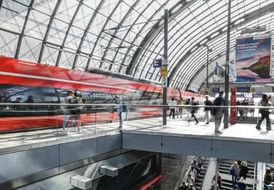Development in the year under review
- Demand trend more or less stable.
- Rental business continues to recover impressively after Covid-19-related restrictions.
- Additional burdens due to the effects of the collective bargaining agreement, higher energy prices, measures in connection with the 9-Euro-Ticket and caring for refugees from Ukraine.
- Measures implemented to save energy and to improve quality and customer satisfaction.
DB Netze Stations | 2022 | 2021 | Change |
2019 | |
absolute | % | ||||
Passenger stations | 5,401 | 5,399 | +2 | – | 5,384 |
Facilities quality (grade) | 2.77 1) | 2.77 1) | – | – | 2.87 |
Customer satisfaction, traffic station (passengers/visitors) (SI) | 71 | 73 | –2 | – | 69 |
Customer satisfaction, traffic station (train operating companies and public transport authorities) (SI) | 68 | 69 | –1 | – | 61 |
Customer satisfaction, tenants (SI) | 79 | 79 | – | – | 79 |
Station stops (million) | 155.9 | 155.5 | +0.4 | +0.3 | 153.3 |
thereof non-Group railways | 44.6 | 46.0 | –1.4 | –3.0 | 40.0 |
Total revenues (€ million) | 1,384 | 1,285 | +99 | +7.7 | 1,339 |
thereof station revenues | 996 | 966 | +30 | +3.1 | 905 |
thereof rental | 350 | 302 | +48 | +15.9 | 393 |
External revenues (€ million) | 593 | 520 | +73 | +14.0 | 590 |
EBITDA adjusted (€ million) | 195 | 160 | +35 | +21.9 | 349 |
EBIT adjusted (€ million) | 29 | 1 | +28 | – | 210 |
Gross capital expenditures (€ million) | 1,434 | 1,380 | +54 | +3.9 | 1,096 |
Net capital expenditures (€ million) | 397 | 297 | +100 | +33.7 | 262 |
Employees as of Dec 31 (FTE) | 6,997 | 6,811 | +186 | +2.7 | 6,216 |
Annual average employees (FTE) | 6,972 | 6,768 | +204 | +3.0 | 6,038 |
Employee satisfaction (SI) | 4.0 | – | – | – | – |
Share of women as of Dec 31 (%) | 44.0 | 44.1 | –0.1 | – | 44.7 |
Absolute primary energy consumption (stations) compared to 2010 (%) | –30.6 | –27.4 | –3.2 | – | –22.1 |
1) Preliminary figure.
Facilities quality remained unchanged.
Customer and visitor satisfaction declined. The survey is conducted on the basis of about 80,000 interviews per year. Customer satisfaction among tenants has stabilized at a high level. The satisfaction of train operating companies and public transport authorities declined slightly.
Station stops were at the previous year’s level. Positive effects resulted mainly from the resumption of transport services, which had been reduced due to Covid-19. Demand for regional transport was almost at the previous year’s level. Restrictions due to construction had a dampening effect here.
The economic trend was heartening and operating profit figures improved significantly. The recovery of the rental business and price effects were the key drivers of this. Higher expenses, in particular for personnel, had a somewhat offsetting effect:
- Revenues: Growth can be attributed in particular to a recovery effect in the rental business following Covid-19-related losses and to regularly increased, price-related higher station revenues mainly from intra-Group customers.
- Other operating income: Significant decline (–24.9%/€ –73 million), mainly driven by lower grants in connection with support programs for the renovation of stations. Growth in the marketing of advertising space to non-Group customers, higher construction grants and an increase in services for intra-Group customers had a mitigating positive effect on income.
On the expenses side, there were additional burdens, in particular from personnel expenses:
- Personnel expenses: Increase (+7.2%/€ +32 million) due to a higher number of employees and as a result of collective bargaining agreements.
- Other operating expenses: Increase (+8.7%/€ +24 million) resulted mainly from increased expenses for rent and IT projects. In addition, among other things, the increase in travel activity and higher other personnel-related costs led to additional burdens.
- Depreciation: Investment-related increase (+4.4%/€ +7 million).
- Cost of materials: Decline (–7.0%/€ –57 million), driven by lower expenses for project-related maintenance and renovations and a decline in Covid-19-related additional hygiene and safety measures at our stations. Energy expenses also fell. Positive effects from energy-saving measures were partially offset by price effects.
Due to higher capital expenditures, mainly in the modernization of existing stations and the construction of new stations, net capital expenditures increased significantly, with investment grants virtually unchanged.
The number of employees increased as a result of an increase in personnel, particularly in the construction management sector.
Employee satisfaction remained at the high level of 2020. Despite operational challenges, the mutual commitment in the team in particular supported overall satisfaction.
The share of women remained almost unchanged at a relatively high level.
With a further reduction in absolute primary energy consumption of stations in comparison to 2010, including through the use of energy-saving technologies, the positive trend of the past years is continuing.


